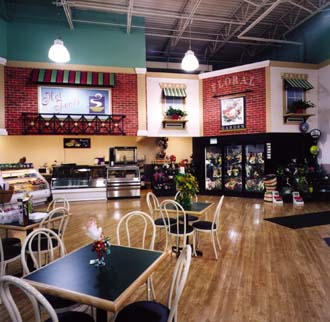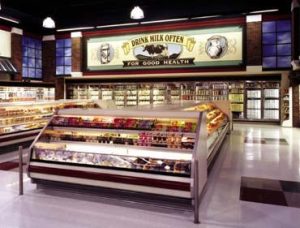Some food shoppers are finding an Italian piazza inside their local grocery store. Some, picking up a gallon of milk inside the dairy aisle, see a blue sky peeking through overhead “windows.”
Such artificial scenes are finding their way into retail environments – in the form of faux architectural graphic elements – thanks in part to the increasing capabilities of large-format digital printing. The result is retailers having more tools to create distinguishable shopping experiences and further strengthen their brand identities.
Among the architectural design elements cropping up in store environments are stone tiles, brick, blue skies and aged-wood planking. These elements are being used alone or to simulate a specific environment, such as outdoor scenery, brick-tiled walls, piazzas and old-fashioned settings.
“These storytelling elements are an extension of a story that immerses the customer in a look and feeling embodying the image of the retail brand,” says Tony Camilletti, vp, strategic development, for Design Fabrications Inc. (D|Fab, Madison Heights, Mich.), an integrated graphics design, printing, manufacturing and installation company. “It's almost a more contemporary trompe l'oeil because when you think about trompe l'oeil, it was always made to look like it was something else.”
Printers such as D|Fab are creating these different faux elements using large-format digital print methods and different types of rolled substrates, including vinyl, magnetic and canvas wallcoverings, Sintra and styrene. “It's application-specific because the substrate is so important to the finished product and what the look is going to be,” says Nadine McLearon, D|Fab's creative director.
For instance, a stippled substrate is used to create brick wallcoverings because the texture simulates the shadows and reflections usually seen in real grout lines. “It aids it in looking more 3-D,” says McLearon.
Another popular faux look is wood grain, in various colors. Camilletti says the wood grain is printed on a vinyl-applied veneer substrate, and then the finished products are applied to cornices, valances, soffits and signage.
“To the customer's eye, it looks like colored wood, and that's really all that matters,” says Camilletti. “This is really about the customer and how she perceives it.”
Retailers are using these faux perceptions for a variety of in-store effects. For instance, the Country Market (Jackson, Miss.) grocery chain uses faux wallcoverings of windows, pilasters and brick walls to create Italian courtyards inside its deli and prepared-foods department. “Everything is there to give you the feeling that you're dining al fresco,” says Camilletti.
To date, the grocery chain has installed the setting at six of its 10 stores, including two renovated locations. Ford Kennedy, Country Market's director of retail sales, says the department, located near store entrances, adds an upscale feel to the shopping and dining areas, while also impacting shoppers' impression of the store.
“Shoppers perceive the food quality is more upscale,” he says, “which helps us compete with fast-food and other takeout purveyors.”
He said the retailer has also used faux architectural elements, including brick walls and farm pictorials, to highlight its produce department. “I think more stores are going upscale, trying to combat bare-wall environments,” says Kennedy.
For a Pick & Save grocery store in Mukwonago, Wis., D|Fab created a distinguishable dairy department using faux brick walls, windows, brick pilasters and a blue sky. “We didn't have the luxury of putting in real windows, so we implied it with graphics,” Camilletti says. “But you still get the feeling that you've walked into another place or space.”
In some cases, the faux environment is accentuated by actual 3-D elements, such as railings, mullions and window boxes. For Country Market's courtyard, designers added canopy-covered windows and balcony railings with hanging flower boxes above the courtyard.
Another benefit of using faux elements inside stores is the ease in which they can be changed out for remodeling. “If you don't have soffit build-outs and bulkheads that have to be torn down, it makes remodeling easier,” says D|Fab's McLearon.
However, she cautions that retailers should keep faux elements out of the reach of customers. “You want to use real things where shoppers can touch them,” she says.
Camilletti says this preserves shoppers' sense of a specific environment, while still giving retailers the opportunity to enjoy the cost-savings available in choosing faux rather than authentic materials, such as tile, brick and wood.
“I've seen so much money wasted on details and finishes that go behind merchandise when there would have been savings had they used something not so real,” says Camilletti. “With faux elements, you can get a bang for your investment buck.”
He adds that this is more important as retail continues to emerge from a volatile economy and a period of cautious growth. “I don't think retailers are ready to go back to business as usual when it comes to building out their store environments,” says Camilletti. “So if they have an option of creating an environment with a more cost-effective solution, why not explore that?”


 Photo Gallery1 week ago
Photo Gallery1 week ago
 Headlines4 days ago
Headlines4 days ago
 Headlines1 week ago
Headlines1 week ago
 Headlines2 weeks ago
Headlines2 weeks ago
 Headlines1 week ago
Headlines1 week ago
 Designer Dozen1 week ago
Designer Dozen1 week ago
 Headlines1 week ago
Headlines1 week ago
 Headlines3 days ago
Headlines3 days ago








